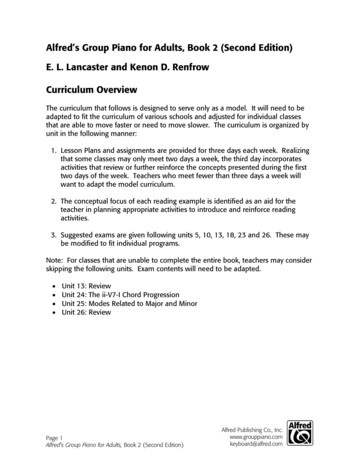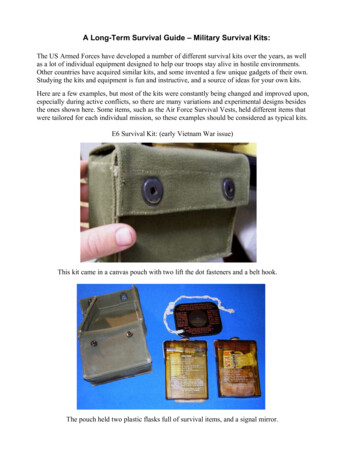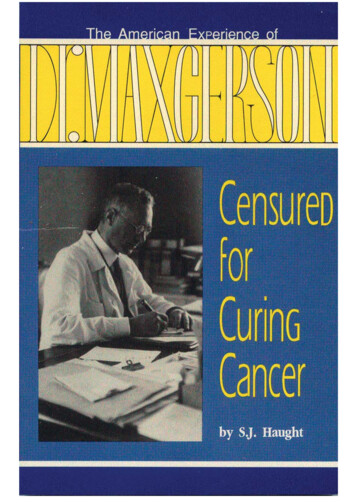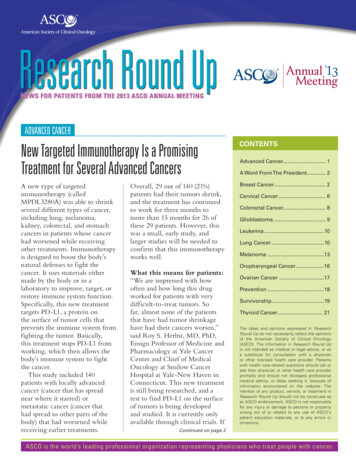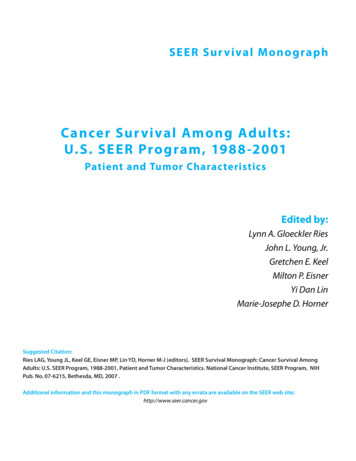
Transcription
SEER Sur vival MonographCancer Sur vival Among Adults:U. S . SE E R Pro g ram , 198 8 -20 01Patient and Tumor CharacteristicsEdited by:Lynn A. Gloeckler RiesJohn L. Young, Jr.Gretchen E. KeelMilton P. EisnerYi Dan LinMarie-Josephe D. HornerSuggested Citation:Ries LAG, Young JL, Keel GE, Eisner MP, Lin YD, Horner M-J (editors). SEER Survival Monograph: Cancer Survival AmongAdults: U.S. SEER Program, 1988-2001, Patient and Tumor Characteristics. National Cancer Institute, SEER Program, NIHPub. No. 07-6215, Bethesda, MD, 2007 .Additional information and this monograph in PDF format with any errata are available on the SEER web site:http://www.seer.cancer.gov
Acknowledgements:The editors and authors would like to thank Kathleen Cronin, Eric Feuer, Leyda Su Ham, Nadia Howlader,Lan Huang, Carol Kosary, Denise Lewis, Angela Mariotto, Barry Miller, Antoinette Percy-Laurry, MarshaReichman, and David Stinchcomb for reviewing this monograph. We are grateful to Peter McCarron, TrishMurphy, Hong Vo, and Philip Zimmerman who provided publication assistance. We also thank the SEERfunded organizations for providing high quality cancer survival data for this monograph.
Dedicated toDr. Charles Smarta dedicated pioneer in the eld of cancer registration and surveillancewhose vision helped establish the blueprint for cancer controlthrough an understanding of cancer incidence and survivalwhile caring about the patients behind the numbers.Lynn & JohnNational Cancer InstituteiiiSEER Survival Monograph
Charles R. Smart was a surgeon, innovator and a man to which faith andfamily mattered foremost. He served in the Army in World War II andgraduated from Temple University School of Medicine. He worked assurgeon at UCLA Medical Center and became Chief of Surgery at LatterDay Saints Hospital (Salt Lake City) in 1975. He served as Director forthe Cancer Division of the American College of Surgeons. He foundedthe Utah Cancer Registry, one of the earliest central cancer registriesin the United States. In 1985, he became chief of the Early DetectionBranch of National Cancer Institute. He was a founding member of theNorth American Association of Central Cancer Registries (NAACCR).He “fathered” cancer registry computer software, and published the rst national data set standard. He received the 1996 David RockefellerSpirit of Service Award for his volunteer work establishing registries inEcuador and Hungary.National Cancer InstituteivSEER Survival Monograph
Table of ContentsChapter 1IntroductionChapter 7Cancer of the PancreasLynn A. Gloeckler Ries, Marie-Josephe D. Horner, andCharles KeyINTRODUCTIONMATERIALS AND METHODSRESULTSDISCUSSIONJohn L. Young, Jr.INTRODUCTIONDATA SOURCESSURVIVAL METHODSDISCUSSION1135Chapter 8Cancer of the LarynxChapter 2Cancers of the Head and NeckJay F. Piccirillo and Irene CostasJay F. Piccirillo, Irene Costas, andINTRODUCTIONMATERIAL AND METHODSRESULTSDISCUSSIONMarsha E. ReichmanINTRODUCTIONMATERIALS AND METHODSRESULTSDISCUSSION7782067676871Chapter 9Cancer of the LungChapter 3Cancers of the Esophagus, Stomach,and Small IntestineLynn A. Gloeckler Ries and Milton P. EisnerINTRODUCTIONMATERIALS AND METHODSRESULTSDISCUSSIONCharles Key and Angela L.W. MeisnerINTRODUCTIONMATERIALS AND apter 10Cancers of the Bone and JointDenise R. Lewis and Lynn A. Gloeckler RiesChapter 4Cancers of the Colon and RectumINTRODUCTIONMATERIALS AND METHODSRESULTSDISCUSSIONKevin C. Ward, John L. Young, Jr., andLynn A. Gloeckler RiesINTRODUCTIONMATERIALS AND METHODSRESULTSDISCUSSION33333441Chapter 11SarcomasLynn A. Gloeckler Ries, Kevin C. Ward, andJohn L. Young, Jr.Chapter 5Cancer of the AnusINTRODUCTIONMATERIALS AND METHODSRESULTSDISCUSSIONMargaret M. Madeleine and Laura M. NewcomerINTRODUCTIONMATERIALS AND apter 12MelanomaMyles Cockburn, David Peng, and Charles KeyChapter 6Cancers of the Liver and Biliary TractINTRODUCTIONMATERIALS AND METHODSRESULTSDISCUSSIONCharles Key and Angela L.W. MeisnerINTRODUCTIONMATERIALS AND METHODSRESULTSDISCUSSIONNational Cancer Institute49495055v939495100SEER Survival Monograph
Table of ContentsChapter 13Cancer of the Female BreastChapter 19Cancer of the VaginaLynn A. Gloeckler Ries and Milton P. EisnerINTRODUCTIONMATERIALS AND METHODSRESULTSDISCUSSIONCarol L. KosaryINTRODUCTIONMATERIALS AND METHODSRESULTSDISCUSSION101101102107Chapter 14Cancer of the Cervix UteriChapter 20Cancer of the Fallopian TubeCarol L. KosaryINTRODUCTIONMATERIALS AND METHODSRESULTSDISCUSSIONCarol L. KosaryINTRODUCTIONMATERIALS AND METHODSRESULTSDISCUSSION111111112121Chapter 15Cancer of the Corpus UteriMary L. Biggs and Stephen M. SchwartzINTRODUCTIONMATERIALS AND METHODSRESULTSDISCUSSION123123124132Chapter 16Cancer of the OvaryAnn Hamilton and Lynn A. Gloeckler RiesINTRODUCTIONMATERIALS AND METHODSRESULTSDISCUSSION133133134144Chapter 17Cancer of the PlacentaCharles F. Lynch, Jessica A. Davila, and145145145146Charles E. PlatzINTRODUCTIONMATERIALS AND METHODSRESULTSDISCUSSIONChapter 18Cancer of the VulvaNational Cancer Institute181181182190Chapter 24Cancers of the Kidney and Renal PelvisCarol L. KosaryINTRODUCTIONMATERIALS AND METHODSRESULTSDISCUSSION171171173179Chapter 23Cancer of the Urinary BladderCarol L. KosaryINTRODUCTIONMATERIALS AND METHODSRESULTSDISCUSSION165165166167Chapter 22Cancer of the ProstateCarol L. KosaryINTRODUCTIONMATERIALS AND METHODSRESULTSDISCUSSION161161161164Chapter 21Cancer of the TestisCarol L. KosaryINTRODUCTIONMATERIALS AND METHODSRESULTSDISCUSSION155155156158Charles F. Lynch, Michele M. West,147147147153Jessica A. Davila, and Charles E. PlatzINTRODUCTIONMATERIALS AND METHODSRESULTSDISCUSSIONvi193194194198SEER Survival Monograph
Table of ContentsChapter 25Cancer of the Brain andOther Central Nervous SystemChapter 31Race and EthnicityJill S. Barnholtz-Sloan, Andrew E. Sloan, andLimin X. Clegg and Lynn A. Gloeckler RiesINTRODUCTIONMATERIALS AND METHODSRESULTSDISCUSSIONAnn G. SchwartzINTRODUCTIONMATERIALS AND apter 26Cancer of the ThyroidCarol L. KosaryINTRODUCTIONMATERIALS AND METHODSRESULTS217217217Chapter 27Hodgkin LymphomaChristina Clarke, Cynthia O’Malley, andSally GlaserINTRODUCTIONMATERIALS AND METHODSRESULTSDISCUSSION227227228233Chapter 28Non-Hodgkin LymphomaChristina Clarke and Cynthia O’MalleyINTRODUCTIONMATERIALS AND METHODSRESULTSDISCUSSION235235237241Chapter 29LeukemiaMarie-Josephe D. Horner and Lynn A. Gloeckler RiesINTRODUCTIONMATERIALS AND METHODSRESULTSDISCUSSION243243244249Chapter 30Cancers of Rare SitesJohn L. Young, Jr., Kevin C. Ward, andLynn A. Gloeckler RiesINTRODUCTIONMATERIALS AND METHODSRESULTSDISCUSSIONNational Cancer Institute251251251261viiSEER Survival Monograph
Table of ContentsNational Cancer InstituteviiiSEER Survival Monograph
Chapter Contributors and EditorsJill S. Barnholtz-Sloan, PhD, MSGretchen E. Keel, BS, BACase Comprehensive Cancer Center, Case Western Reserve University School of Medicine;Cleveland, OHInformation Management Services, Inc;Silver Spring, MDMary L. Biggs, PhD, MPHDepartment of Biostatistics, School of PublicHealth and Community Medicine,University of Washington, Seattle, WADepartment of Pathology and New Mexico TumorRegistry, Cancer Research & Treatment CenterThe University of New Mexico School of Medicine; Albuquerque, NMChristina Clarke, PhDCarol L. Kosary, MANorthern California Cancer Center; Fremont, CA;Stanford University; Stanford, CACancer Statistics Branch, Surveillance ResearchProgram, National Cancer Institute, NIH, DHSS;Bethesda, MDCharles R. Key, MD, PhDMyles Cockburn, PhDDenise R. Lewis, PhDDepartment of Preventive Medicine, Universityof Southern California, Keck School of Medicine;Los Angeles, CACancer Statistics Branch, Surveillance ResearchProgram, National Cancer Institute, NIH, DHSS;Bethesda, MDIrene Costas, MPHClinical Outcomes Research Of ce,Department of Otolaryngology Head and NeckSurgery, Washington University School of Medicine; St. Louis, MO.Yi Dan LinJessica A. Davila, PhDDepartment of Epidemiology,The University of Iowa; Iowa City, IASchool of Medicine, Monash University; Melbourne, AustraliaCharles F. Lynch, MD, PhDSection of Health Services Research,Department of Medicine, Baylor College ofMedicine; Houston, TXMargaret M. Madeleine, PhD, MPHProgram in Epidemiology, Public Health SciencesDivision, Fred Hutchinson Cancer Research Center; Seattle, WAMilton P. Eisner, PhDCancer Statistics Branch, Surveillance ResearchProgram, National Cancer Institute, NIH, DHSS;Bethesda, MDAngela L.W. Meisner, MPHNorthern California Cancer Center; Fremont, CA;Stanford University; Stanford, CADepartment of Pathology, and Division ofCancer Epidemiology, Cancer Center,University of New Mexico School of Medicine;Albuquerque, NMAnn S. Hamilton, PhDLaura M. Newcomer, PhDPreventive Medicine, Division of Epidemiology,University of Southern California, Keck School ofMedicine; Los Angeles, CAProgram in Epidemiology, Public Health SciencesDivision, Fred Hutchinson Cancer ResearchCenter; Seattle, WAMarie-Josephe D. Horner, MSPHCynthia O’Malley, PhDCancer Statistics Branch, Surveillance ResearchProgram, National Cancer Institute, NIH, DHSS;Bethesda, MDFormerly with Northern California Cancer Center; Fremont, CA; Dr. O’Malley is currently withGlobal Biostatistics and Epidemiology, Amgen,Inc.; Thousand Oaks, CASally Glaser, PhDNational Cancer InstituteixSEER Survival Monograph
Chapter Contributors and EditorsDavid Peng, MD, MPHAndrew E. Sloan, MD, FACSDepartment of Dermatology, University ofSouthern California, Keck School of Medicine,and Norris Cancer Center; Los Angeles, CADepartment of Neurosurgery, University Hospitalof Cleveland-Case Western University MedicalSchool; Cleveland, OHJay F. Piccirillo, MDKevin C. Ward , MPHClinical Outcomes Research Of ceDepartment of Otolaryngology-Head and NeckSurgery, Washington University School of Medicine; St. Louis, MOGeorgia Center for Cancer Statistics, RollinsSchool of Public Health, Emory University;Atlanta, GACharles E. Platz, MDDepartment of Epidemiology, The University ofIowa; Iowa City, IAMichele M. West, PhDUniversity of Iowa College of Medicine;Department of Epidemiology, College of PublicHealth, University of Iowa; Iowa City, IAJohn L. Young, Jr., DrPH, CTRGeorgia Center for Cancer Statistics, RollinsSchool of Public Health, Emory University;Atlanta, GAMarsha E. Reichman, PhD, MSCancer Statistics Branch, Surveillance ResearchProgram, National Cancer Institute, NIH, DHSS;Bethesda, MDLynn A. Gloeckler Ries, MSCancer Statistics Branch, Surveillance ResearchProgram, National Cancer Institute, NIH, DHSS;Bethesda, MDAnn G. Schwartz, PhD, MPHDepartment of Internal Medicine, Karmanos Cancer Institute, Wayne State University School ofMedicine; Detroit, MIStephen M. Schwartz, PhDProgram in Epidemiology, Division of PublicHealth Sciences, Fred Hutchinson Cancer Research Center; Seattle, WANational Cancer InstitutexSEER Survival Monograph
Chapter 1IntroductionLynn A. Gloeckler Ries, Marie-Josephe D. Horner, andJohn L. Young, Jr.INTRODUCTIONCancer Survey), the SEER Program has evolved in response to the mandate of the National Cancer Act of 1971,which requires the collection, analysis, and disseminationof data relevant to the prevention, diagnosis, and treatment of cancer. The SEER Program (http://seer.cancer.gov) collects cancer incidence, treatment, and survivaldata which are used to monitor the burden of cancer onthe population of the United States. The NCI contractswith medically-oriented nonprofit institutions, such asuniversities and state health departments, to obtain dataon all in situ and invasive cancers diagnosed in residentsof the SEER geographic areas, except for basal cell andsquamous cell carcinomas of the skin and in situ cervical cancer.The Surveillance, Epidemiology, and End Results (SEER)Program of the National Cancer Institute (NCI) has devotedthis monograph to examining cancer survival by patientand tumor characteristics for cancers diagnosed during theperiod 1988-2001. The analyses focus on cancer survivalin adults aged 20 years and older, with the exceptions ofacute lymphoblastic leukemia (all ages), placenta (ages15 ), and Hodgkin lymphoma (ages 15 ). This chapterdescribes the sources of the data and the methods used. Italso provides a summary of the results. Each subsequentchapter focuses on a distinct anatomical site and associated histologies.The analyses in this monograph are based on data from12 geographic areas representing approximately 14% ofthe United States population: the States of Connecticut,Iowa, New Mexico, Utah, and Hawaii; the metropolitanareas of Detroit, Atlanta, San Francisco, San Jose, LosAngeles, and Seattle; and ten counties in rural Georgia.Cases were diagnosed during the period 1988-2001 andfollowed through 2002. All registries contributed data fordiagnosis years 1988-2001, except Los Angeles, whichcontributed data for 1992-2001.DATA SOURCESSurveillance, Epidemiology, and End Results(SEER) ProgramThe Surveillance, Epidemiology, and End Results (SEER)Program was established in 1973 as part of the NationalCancer Institute (NCI). A sequel to two earlier NCI initiatives (the End Results Program and the Third NationalTable 1.1: All Cancers: Number of Cases and Exclusions, 12 SEER Areas, 1988-2001Number Selected/RemainingNumber ExcludedReason for Exclusion/Selection2,246,6030Select 1988-2001 diagnosis (Los Angeles for 1992-2001 only)1,925,529321,074Select rst primary only1,901,06724,462Exclude death certi cate only or at autopsy1,874,43226,635Exclude unknown race1,870,2294,203Active follow-up and exclude alive with no survival time1,846,16224,067Exclude children (000-019)1,736,210109,952Exclude in situ cancers for all except breast & bladder cancer1,660,37675,834Exclude no or unknown microscopic con rmation1,629,96430,412Exclude sarcomasNational Cancer Institute1SEER Survival Monograph
Chapter 1IntroductionA total of 1,629,955 primary cancers were used in analyses.Survival rates are calculated on demographic and tumorinformation. Cases of second or later primaries, casesidentified by death certificate or autopsy only, cases ofunknown race, and those alive with no follow-up wereexcluded from the analysis (Table 1.1).extension and lymph node fields are specific to the site ofthe primary tumor. The detail and amount of informationcollected for EOD have varied over time.StageStage of disease is determined from EOD information.In this monograph several different staging systems wereused depending on the extent of disease information available. The American Joint Committee on Cancer’s (AJCC)Staging Manual for the third edition (3), the fifth edition(4), and sixth edition (5) TNM: tumor size/extent (T),node involvement (N), and distant metastases (M) andthen combines TNM into stages. Sometimes additionalinformation is needed such as grade.The SEER data are available for analyses by researchers.See www.seer.cancer.gov for further information.SEER*Stat SoftwareThe SEER*Stat statistical software, a convenient, intuitive mechanism for the analysis of SEER and othercancer-related databases, was used for analyses. It is apowerful PC tool to view individual cancer records andto produce statistics for studying the impact of canceron a population. It is available at the following website:http://seer.cancer.gov/seerstat/Since 1988, the tumor extension information in EOD iscollected utilizing only one variable (except for prostatesince 1995) and is based on the best information availableon the furthest extension of the tumor. For some AJCCschemas, there is both a clinical T and a pathologic T.Therefore, in the conversion from EOD to AJCC, the Tinformation is based on a combination of clinical andpathologic information. If there are distant metastases,the SEER EOD conversion will be TX M1, i.e. the Tinformation is not recorded. Similarly, if distant nodesare involved, the information on regional nodes is notrecorded in SEER. For many primary sites AJCC tumorextension classifications can range from T0 to T4 withsubcategories, node involvement classifications can rangefrom N0 to N3 with subcategories, and metastasis classifications can range from M0 to M1. The AJCC T, N,and M are then combined into stage ranging from Stage0 through Stage IV. There are some primary sites forwhich there is no TNM and/or no AJCC stage. For allcancer sites except bladder and breast, in situ lesionswere excluded from the analyses. For most cancer sites,this means that Stage 0 is excluded, but for breast andcolon/rectum, Stage 0 includes more than in situ alone.For colon/rectum, Stage 0 also includes cases confinedto the lamina propria with no nodes and for breast, Pagetdisease with no underlying tumor.Tumor InformationThe SEER program collects the month and year of diagnosis, primary tumor site, behavior, histology, extent ofdisease at diagnosis, and, starting in 1990, breast cancerreceptor status. The International Classification of Diseases for Oncology, 2nd edition (ICD-O-2) (1) was thestandard reference for classifying primary site, histology,behavior and grade. The ICD-O-2 tumor site and morphology codes allow for precise coding of tumor location(including sub-location within an organ) and histology.For 2001 cases, the third edition of ICD-O (ICD-O-3)was used and all prior histology data were converted toICD-O-3 (2).The histologic grade of malignant tumors is also collected:grade I is well differentiated; grade II is moderately differentiated; grade III is poorly differentiated, and gradeIV is undifferentiated or anaplastic (1, 2). For leukemiasand lymphomas, the grade code can reflect T-cell, B-cell,and N-K cell phenotype.Extent of DiseaseTo perform the analyses in this monograph covering datafrom 1988-2001, it was necessary to achieve consistency ofthe stage variable over time. Changes to EOD were madein 1988 to be compatible with the AJCC third edition.In 1998, some of the EOD schemas were changed to becompatible with the fifth edition of AJCC so that SEEREOD information could be easily converted into the TNMstaging classifications based on the fifth edition of theAJCC Manual for Staging of Cancer. Therefore, dependingSEER has collected extent of disease (EOD) informationon all cancers since the inception of the program. Extentof disease information since 1988, consists of five dataitems: tumor size where applicable, extension (withinthe primary site or contiguous or metastatic), highest involved lymph node chain, number of regional lymph nodesfound positive (with certain exceptions), and number ofregional nodes examined (with certain exceptions). TheNational Cancer Institute2SEER Survival Monograph
Chapter 1Introductionfew places the SEER historic stage is used. The SEERSummary Staging Manual 2000 lists the definitions forSEER Summary Stage 2000 and in the footnotes for eachsite describes how the SEER Summary Stage 1977 andthe SEER historic stage differ from it (7).on the cancer site and the changes between the third andfifth editions of AJCC, some chapters present data according to the AJCC third, AJCC fifth, or a different stagedefinitions (see below). Except for lymphomas, the AJCCstaging criteria were applied to all histologies for eachprimary site. In some chapters, a SEER modified AJCCstage was used. The main difference between the SEERmodified and AJCC versions, is that NX was combinedwith N0 in the conversion of TNM to AJCC stage.SURVIVAL METHODSThe observed survival rate, obtained using the actuarial(life table) method, is the proportion of cancer patientssurviving for a specified time interval after diagnosis.The expected survival rate for a hypothetical cohort ofpersons of the same sex, age, and race as the patientcohort is the proportion, based on the 1990 life table, ofthe given cohort that will survive to the end of the giventime interval. For some sites, median survival times arepresented. The median survival time is based on the observed survival rate and is defined as the point at which50% have died and 50% are alive.SEER has also used a more simplistic stage with five levels:In situ tumors are those that have not yet broken throughthe adjacent basement membrane. For most cancer sitestreated in this monograph, in situ tumors are excludedfrom the analysis; the urinary bladder and the femalebreast are exceptions. The term localized describes tumors,regardless of size, that are confined to the organ of origin.Regional tumors are those that have metastasized to theregional lymph nodes or have extended directly from theorgan of origin. Distant describes a tumor whose metastases have traveled to other parts of the body. (Leukemiaand myeloma are considered distant at diagnosis.) Wheninformation is not sufficient to assign a stage, a cancer issaid to be Unstaged or Unknown. Most of the chapterswhich use stages of localized, regional, and distant arebased on the SEER Summary Stage (1977) (6). Basedon the same principles as Summary Stage 1977, SEERhas used more historical definitions that are more consistent over time for historical trends back to 1973. In aMost of the survival analyses in this monograph is basedon the relative survival rate (8), except in Chapter 31on race and ethnicity, where the cause-specific survivalrate (9) is used.Relative survival is a net survival measure representingcancer survival in the absence of other causes of death.Relative survival is defined as the ratio expressed as apercent, of the proportion of observed survivors in a co-Table 1.2: Ten Most Common Cancer Sites: 1-, 2-, 3-, 5-, 8- & 10-Year Relative Survival Rates by Site, Ages 20 , 12 SEER Areas,1988-2001Relative Survival Rate (%)SiteAll sites (except male andfemale breast in 00.0100.0Breast (female, 8911.583.375.169.963.659.257.7ProstateBreast (female, in ary n Lymphoma65,9324.274.266.362.156.349.947.0Uterine Corpus48,6423.193.589.587.084.783.182.6Leukemia (all ages)42,6782.767.058.053.447.240.738.1Kidney and Renal Pelvis32,5832.180.873.870.465.560.957.9National Cancer Institute3SEER Survival Monograph
Chapter 1Introductionrelative survival rates are presented for some sites conditioned on specific times after diagnosis. For some siteswhere survival is very poor, the eight year survival ratemay obscure that for the small group of patients who havealready survived 3 years, their probability of surviving thenext 5 years may be quite high.hort of cancer patients (the observed survival rate definedabove) to the proportion of expected survivors (the expectedsurvival rate defined above). Thus, a relative survival of100% means that a cancer patient cohort is just as likelyto survive the given interval as a cohort in the generalpopulation of the same sex, age, and race. It does not meanthat everyone will survive their cancer. For example, ina group of screening found cancers, many of the peopleseek medical care on a more routine basis than the generalpopulation and may have better non-cancer survival thanthe general population. In this case the expected life tableis too low which makes the relative rate too high. On theother hand, lung cancer patients who smoke may be atexcess risk of dying of other smoking related causes thanthe general population and the calculated expected ratewould be too high which means that the relative survivalrate may be lower than it would be if life tables based onsmoking could be used.For certain racial and ethnic groups, the life tables thatare typically used for calculating expected survival do notaccurately represent the experience of that specific racial/ethnic population. Since the calculation of relative survivalrates needs accurate life tables, the relative survival ratesare not shown for race/ethnic groups other than white orblack in the individual site chapters. In order to presentinformation for race/ethnic groups other than white patientsor black patients, a cause-specific (c-s) survival rate wasused. Since survival calculated under different methodscan not be compared to one another, the survival rates formore specific racial/ethnic groups were put in a specialchapter on race-and-ethnicity, Chapter 31. The c-s rate isdependent on knowledge not only of the date of death butalso accurate information on the cause of death. The c-srate is similar to the observed survival rate except that onlypatients who died of their cancer are considered as deathsand patients who died of other causes are ‘censored’ at thetime of death. This method avoids problems of finding appropriate expected survival rates which are needed for therelative survival rate, but is dependent on which cause ofdeaths are considered due to the cancer. The cause-specificrate, however, is dependent on accurate cause of death (COD)information. When the population used in calculating theexpected survival is similar to the population of cancerpatients except for the latter’s cancer experience, the relative survival rate and the cause-specific survival rate willWhile many times 5-year relative survival rates are presented, a five year rate may be less informative than asurvival rate over a shorter time frame for a site or groupwith poor survival or over a longer time frame for a site orcharacteristic with good survival. Up to 10-year survivalrates are shown for many sites.The conditional survival rate, while difficult to explain,may be the most clinically informative of the survival rates.Instead of evaluating survival from diagnosis, for examplea 5-year relative survival rate from diagnosis, the conditional survival rate can start anytime after diagnosis, i.e., itis conditioned on the cohort surviving to that point of timeand then a survival rate is calculated for the patients whohave survived to that point. For this monograph, 5-yearTable 1.3: Ten Most Common Cancer Sites: Five-Year Relative Survival Rates by Sex and Race, Ages 20 , 12 SEER maleMaleFemaleMaleFemaleAll sites (except male and female Breast insitu)ProstateBreast (female, in 0.052.998.4n/a93.5n/an/a100.0n/a100.0Breast (female, .354.9Melanoma90.088.292.188.492.470.176.3Urinary Bladder81.984.075.984.877.369.355.4Non-Hodgkin Lymphoma56.352.560.953.461.543.454.8Uterine Corpus84.7n/a84.7n/a86.4n/a61.8Leukemia (ages 0-19 and 20 )47.248.046.249.647.637.237.9Kidney and Renal Pelvis65.565.266.065.966.261.464.8National Cancer Institute4SEER Survival Monograph
Chapter 1IntroductionTable 1.4: Number of Cases by Leading Cancer Site and Stage at Diagnosis, 5-Year Relative Survival Rates, Ages 20 , 12 SEERAreas, 1988-2001Relative SurvivalSiteProstateBreast (female, 70Urinary n Lymphoma19,97169.49,09861.130,46844.36,395Uterine Corpus35,64695.77,23766.23,99326.01,766Kidney and Renal Pelvis17,59190.47,31660.26,5988.21,078@ Local combined with Regional for Prostatebe nearly equal. That is, the relative survival rate closelyindicates the probability that a patient will not die due tocancer-related causes within the given time interval. Whenthe population used for the expected survival is dissimilarto the population of cancer patients, the relative survivalmay differ from the cause-specific survival rate by tumorand patient characteristics. Comparisons of survival ratesshould be based on the same survival method for calculating rates.Blacks seem to fare worse with this disease, where the5-year survival rate is 69% among black males and 55%among black females.Survival by summary stage is presented in Table 1.4 forselect cancers. The differences in 5-year survival by stageare notable. The earlier the stage at diagnosis, the more favorable is the 5-year survival. For screenable cancer sites,survival ranges from 91% at localized stage to 9% at distantstage for colorectal cancer, and 97% at localized stage to24% at distant stage for female invasive breast cancer. Othercancer sites are as extreme in terms of survival by stage ofdiagnosis (urinary bladder, melanoma).RESULTSRelative survival up to 10 years after diagnosis of invasivecancer is shown in Table 1.2 for patients diagnosed in the12 SEER catchment areas during 1988-2001. Survival ratesvary substantially according to the cancer site. Amongthe most frequently diagnosed cancers, the sites with thehighest 10-year relative survival rates are prostate, femalebreast in situ, uterine corpus, and melanoma, which have10-year relative survival rates of 83% (uterine corpus) to100% (female breast in situ). Lung cancer has the leastfavorable survival across the 10-year period following diagnosis (11%).DISCUSSIONMany times in population-based statistics the emphasisis on incidence and mortality statistics. While these areimportant in measuring cancer, they are not as relevant tothe medical community concerned about prognosis. Thefocus of this monograph is to present descriptive analysesof cancer survival by patient and tumor characteristics.Since the emphasis is on the influence of patient and tumorcharacteristics on survival and not on how survival rateshave changed over time, a discussion of biases in survivaltrends
Cancer Survival Among Adults: U.S. SEER Program, 1988-2001 Patient and Tumor Characteristics Edited by: Lynn A. Gloeckler Ries John L. Young, Jr. Gretchen E. Keel Milton P. Eisner Yi Dan Lin Marie-Josephe D. Horner Suggested Citation: Ries LAG, Young JL, Keel GE, Eisner MP, Lin YD, Horner M-J (editors). SEER Survival


